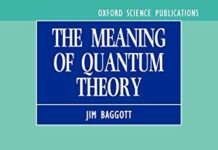
Ebook Info
- Published: 2011
- Number of pages: 320 pages
- Format: PDF
- File Size: 2.40 MB
- Authors: Jim Baggott
Description
The twentieth century was defined by physics. From the minds of the world’s leading physicists there flowed a river of ideas that would transport mankind to the pinnacle of wonderment and to the very depths of human despair. This was a century that began with the certainties of absolute knowledge and ended with the knowledge of absolute uncertainty. It was a century in which physicists developed weapons with the capacity to destroy our reality, whilst at the same time denying us the possibility that we can ever properly comprehend it. Almost everything we think we know about the nature of our world comes from one theory of physics. This theory was discovered and refined in the first thirty years of the twentieth century and went on to become quite simply the most successful theory of physics ever devised. Its concepts underpin much of the twenty-first century technology that we have learned to take for granted. But its success has come at a price, for it has at the same time completely undermined our ability to make sense of the world at the level of its most fundamental constituents. Rejecting the fundamental elements of uncertainty and chance implied by quantum theory, Albert Einstein once famously declared that ‘God does not play dice’. Niels Bohr claimed that anybody who is not shocked by the theory has not understood it. The charismatic American physicist Richard Feynman went further: he claimed that nobody understands it. This is quantum theory, and this book tells its story. Jim Baggott presents a celebration of this wonderful yet wholly disconcerting theory, with a history told in forty episodes — significant moments of truth or turning points in the theory’s development. From its birth in the porcelain furnaces used to study black body radiation in 1900, to the promise of stimulating new quantum phenomena to be revealed by CERN’s Large Hadron Collider over a hundred years later, this is the extraordinary story of the quantum world.Oxford Landmark Science books are ‘must-read’ classics of modern science writing which have crystallized big ideas, and shaped the way we think.
User’s Reviews
Editorial Reviews: From Publishers Weekly Starred Review. “The reality of scientific endeavour is profoundly messy, often illogical, deeply emotional, and driven by the individual personalities involved…,” writes Baggott, and his wonderful history of the scientists and ideas behind quantum mechanics offers ample entertaining proof. Science writer Baggott (A Beginner’s Guide to Reality) tells the tumultuous story through 40 key events, beginning at the start of the 20th century, when Lord Kelvin, a British physicist, announced that scientists now knew everything about how the world worked. That triumphalism soon disappeared with Einstein’s groundbreaking papers on relativity, which upended that understanding and defined the battleground that would occupy physics for the next century. Baggott hits all the usual high points, from Niels Bohr’s work on atomic structure to the “uneasy alliances” and outright battles between proponents of different theories. Baggott’s narrative stands out for its parallel exploration of the tenacious, all-too-human side of things: Schrödinger’s unorthodox sex life and his loathing of academia; Richard Feynman’s intuitive problem solving with all its “enthusiastic handwaving.” The basic history behind the quantum revolution is well-known, but no one has ever told it in quite such a compellingly human and thematically seamless way. 16 pages of b&w illus. (Apr.) (c) Copyright PWxyz, LLC. All rights reserved. Review “I have never come across a book quite like Jim Baggott’s ‘The Quantum Story.’ He has done something that I would have thought impossible in a popular book. He manages to present the full ambit of the theory, starting with the introduction of the quantum–the basic unit of energy–by the German physicist Max Planck in the beginning of the 20th century, and ending with the search for the Higgs particle at the collider at CERN in Geneva. In doing this Mr. Baggott navigates successfully between the Scylla of mathematical rigor and the Charybdis of popular nonsense. He also manages to get the people right. I know this because for many of the scenes he describes I was there.”–Jeremy Bernstein, The Wall Street Journal “The history is as complex and involved as the theory itself, and Jim Baggott’s history-through-vignettes approach brings out a wealth of fascinating detail about the personalities, philosophies and rivalries that guided its course…there are many good moments to be had.” – New Scientist “The basic history behind the quantum revolution is well-known, but no one has ever told it in such a compellingly human and thematically seamless way.” – Publishers Weekly ..”.engrossing.” – Booklist”Baggot shines…Those with a jones for physics will not be disappointed…Quantum theory may deny us the possibility of properly comprehending physical reality, but Baggott’s account is smart and consoling.” – Kirkus Reviews”An accessible and informative history” – Science “Intellectually gratifying.” –The Economist About the Author Jim Baggott, Freelance science writerJim Baggott is a freelance science writer. He was a lecturer in chemistry at the University of Reading but left to work with Shell International Petroleum Company and then as an independent business consultant and trainer. His many books include Origins: The Scientific Story of Creation (OUP, 2015), Higgs: The Invention and Discovery of the ‘God Particle’ (OUP, 2012), and A Beginner’s Guide to Reality (Penguin, 2005). Read more
Reviews from Amazon users which were colected at the time this book was published on the website:
⭐This book relates the historical development of quantum mechanics, and should serve as a useful adjunct to quantum mechanics textbooks. I liked this book a lot and highly recommend it to physicists and students of physics, both those taking university courses and those seriously studying on their own. However, I do not recommend the book for those with only a very limited knowledge of physics, because while no equations are presented the book is replete with somewhat in depth discussions of some of the finer points of the subject, particularly with regards to the interpretation of the Schrodinger wave equation, the meaning of the uncertainty principal and on the EPR experiment. All this is best illustrated by discussing what is in this book.What is in the book –The book discusses the development of quantum mechanics from 1900 to 2010, as depicted by 40 “moments”- critical junctures in time. These 40 moments are divided into seven parts, as follows:Part I – Quantum of Action. This part details the origin of the idea of quanta, first developed by Max Planck in 1900. It goes on to Einstein’s application of Planck’s ideas and to additional developments, up to 1925, including the work of Heisenberg, deBroglie and Schrodinger. I found this to be a very entertaining and informative part or the book as it mixes basic ideas of physics with a bit of the biographies of the men who development them. This approach is carried out throughout the book, with some biographical information accompanying the physics discussions.Part II – Quantum Interpretations. This part of the book discusses the various interpretations of the meaning of quantum mechanics and the controversies that developed, covering the period of 1925-27.Part III – Quantum Debate – This part of the book further amplifies the debate about the meaning of quantum mechanics during the period of 1927-47. It focuses on Einstein’s reservations and his EPR thought experiment that sought to show that quantum mechanics, as it was formulated, was incomplete.Part IV – Quantum Fields – This part of the book, covering the period of 1947-67, focuses on the development of quantum field theory and quantum electro-dynamics. I liked the development of Feynman’s approach and how it compared to that of Schwinger and Tomonaga. It also goes into the beginnings of the development of the quark model.Part V – Quantum Particles – This section deals with the development of the standard model, covering 1968-2003. I found this and the preceding sections to be the most difficult when they delved into the ideas of group theory. Part IV contains a good description of the relation of symmetry to basic conservation laws, but then the author jumps to group theory and then to its application to particle physics, but without explaining very much about group theory and even less about how it is applied to the problems of describing the interior of the atom and the interior of protons, neutrons and of the particles that are observed in accelerator experiments, some of which are also found in nature due to cosmic ray collisions.Part VI – Quantum Reality – I found the discussions of Bell’s theorem and Bell’s inequality to be excellent. I learned that there are many version of the experiments meant to investigate this inequality and determine if “reality” is local or non-local, and that there are newer types of expressions of the sort that Bell developed that are being tested. This part of the book covers the period of 1951- 2006.Part VII – Quantum Cosmology – This part of the book deals with quantum mechanics, its application to cosmology (especially through the work of Hawking) and to attempts to develop a theory that encompasses both gravity and the standard model for particle physics. This part of the book covers these subjects from 1966-2000. There is also a brief epilogue that discusses the search for the Higgs particle up to 2010.
⭐Jim Baggott manages to combine a fascinating historical account of the development of quantum theory from its inception, together with a description of its main ideas to a level beyond most “popular” accounts. He has assembled in story-telling fashion the people, their ideas, their interactions and the considerable drama. The author must have combed through many hundreds of letters, journal articles, and personal accounts by the principals, as well as numerous secondary sources, contempory newspaper accounts, and also his personal contacts. The sources of the many direct quotations are annotated in a back section, and an extensive bibliography adds to the overall value of the book.As far as the mathematics goes (referred to in other reviews on Amazon), there appears none beyond basic algebra. A couple well-known equations are spelled out (Planck’s and Einstein’s). All formulae appear in-line with the text (not textbook-style as numbered equations). I noticed one place where a more complicated equation was described in words. My overall impression is that Baggott has injected just the necessary equations and formulae to illuminate and streamline the text. Beyond that, Baggott’s patient, highly polished prose achieves an amazing balance of working through quantum mechanics, quantum field theory, the standard model, etc. at a descriptive level while retaining the flavor and spirit of the material.However, I would concur that this material could be pretty challenging as someone’s first exposure to QM. Much better off would be the Scientific American reader, for example. On the other side of the coin, the book will broaden and considerably enliven the subject matter for someone aleady exposed to introductory QM, as for example during a first undergraduate course.An inclusion I especially liked was the “centerfold” 16 pages of black-&-white photos featuring famous physicists and some major events. This kind of glossy-paged supplement has become somewhat rare in non-fiction books these days.The book’s story ends around 2010 with supersymmettry and string theory still in the excitement stages. I gather that a bit of the gloss has come off these since then. But such progress or evolution of thinking is to be expected in such an active field.
⭐Jim Baggott is taking on a path well travelled in this recounting of the quantum story. His mode of travel works well, concentrate on the human element, stretch the reader with the technical details and don’t oversimplify.You don’t get a Guernsey telling this kind of history without really knowing your stuff, and Baggott shows that he does. For the early chapters, the explanations of quantum theory are as good as any I have read – De Broglie’s dual wave-particle hypothesis, Heisenberg’s matrix mechanics and Born’s rationalisation of the wave function are stand-outs. The shadow of Einstein falls over all players and debate, and Baggott’s explanations of the gedankenexperiments of Einstein and others enrich the story.Baggott’s rendition of the middle era of quantum theory after WWII gets a little turgid, with many layers of detail hanging a little limply without more mathematical backbone. The evolution and testing of the Standard Model was laborious in real life, so I guess the story needs to impart some of that. Again, Baggott really knows his stuff so, while this era is slow to wade through, I expect the index will provide the reader with a good reference to be reminded of an overview or context on specific points long after the back cover is closed. The modern era is well described and wide-ranging to help the reader see how topics such as string theory and supersymmetry have influenced modern quantum physics.Baggott’s writing is crisp and his insights and anecdotes are told, or retold, in a fresh style. It’s a long story and worth the investment.
⭐One of the best books I have ever read.It is incredibly concise and to the point, without useless details, while still getting a lot of information across. You cannot get bored reading this book.The content is difficult, and I only recommend reading this if you have a particular interest in physics. You must have a brief understanding of concepts like: wave particle duality, diffraction experiments, quantum numbers,Rutherford’s gold scattering experiments, E=mc2, E=hc, the Heisenberg uncertainty principle etc. it does not go into explaining the concepts enough if you are reading about them for the first time, but this is the best book ever for people interested in physics and who have an understanding of what is mentioned in the book.It gives a great account on how everything was found, and how many of the great Physicists worked together, and on their opinions on each other’s finding‘s.This is not taught in most schools and physics textbooks so this is a very interesting and intriguing book.
⭐Fascinating and well written, particularly the first half of the book.However the last sections on the newer aspects of quantum theory are very difficult to understand/read. Strangely, the editor/author has chosen to provide almost no illustrations, tables or mathematics to help the reader without background. I struggled with the last chapters, although I have a medical scientific background the last chapters are extremely difficult to understand. This book could be much improved by incorporation of more mathematics,illustrations and tables, unfortunately it seems as if the editor must have been sleeping.
⭐Not an easy read because of the subject matter. Each chapter follows the developing standard model and reveals the personalities and rivalries between the protagonists. The book works at several levels and is thought provoking throughout. A strangely charming read.
⭐Concise chronological developmentof quantum physics in straightforward language. Highly recommended for specialists and non-specialists alike.
⭐Bought as a gift for my Dad, who is a physicist/engineer and very into reading popular science. He said this was one of the most enjoyable and well written books he’d read in a long time and we could barely rouse him from it on boxing day. It’s unusual for him to comment on a book unless it’s terrible so that’s grand praise indeed!
Keywords
Free Download The Quantum Story: A history in 40 moments in PDF format
The Quantum Story: A history in 40 moments PDF Free Download
Download The Quantum Story: A history in 40 moments 2011 PDF Free
The Quantum Story: A history in 40 moments 2011 PDF Free Download
Download The Quantum Story: A history in 40 moments PDF
Free Download Ebook The Quantum Story: A history in 40 moments



